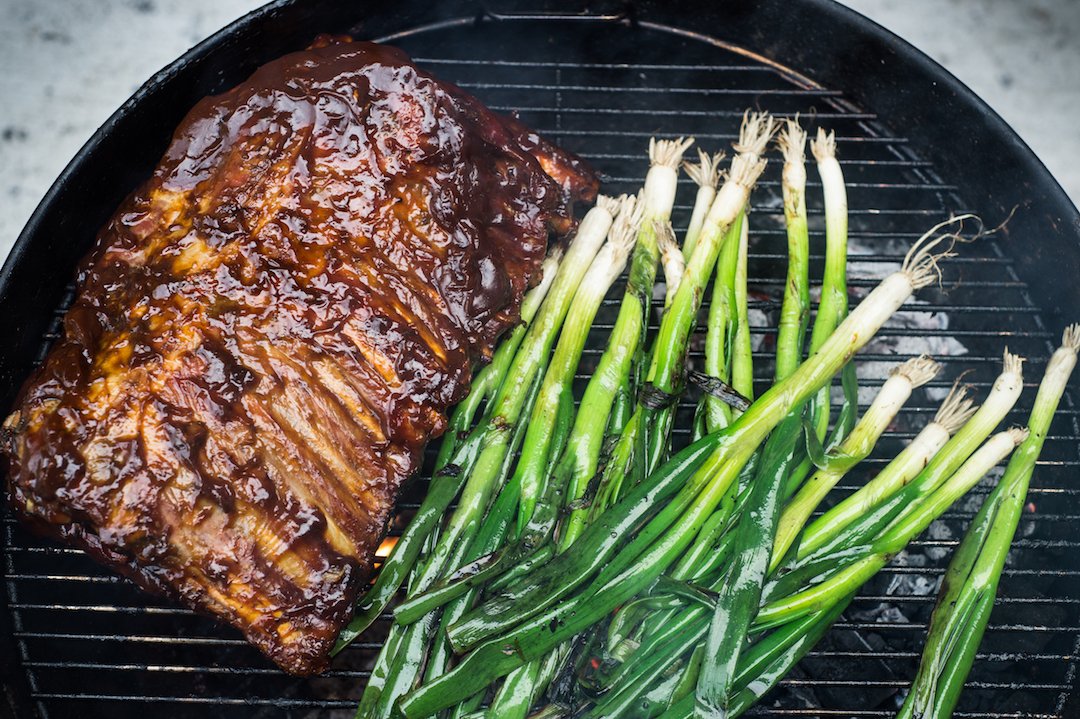Josh Applestone's Barbecue Sauce With Pork Rib Tips
Good barbecue sauce is a thing of beauty. Maybe you have a bottled sauce you love and keep in stock in your kitchen cabinet. You can’t mess with perfection. Still, if you’re a fan and have yet to try making it yourself, you should. It’s simple and you can adjust your sauce pretty much any way that suits your taste. If you’re ready to try to make your own barbecue sauce, here are two basic recipes Josh Applestone put together. They’re geared at the masses on purpose. One is sweet and the other is more savory. “Keep in mind that all of my recipes are an idea. If you like it sweeter or saltier, definitely do that,” says Applestone, who personally likes his BBQ sauce spicy. “People think way too much about recipes. They are just a suggestion. And if something calls for two cups of honey and you only have one cup, do one cup.”
THE METHOD
Applestone pulls his ingredients together and puts them in a saucepan with the lid off on the stove over medium heat for ten to fifteen minutes maximum. The point is to let the warmth activate the ingredients and give the sauce a more cohesive, balanced flavor. You can stir the ingredients together until you notice they’re thickening, but don’t let it bubble or boil. “It gets nasty,” warns Applestone. After you heat your sauce, let it cool to room temperature, then chill it overnight before using. If you think it looks too liquidy, keep in mind that it will thicken in the fridge. Add water if it’s too thick when you go to use it. If it’s too loose, just heat it up again; the water will evaporate.
ADJUST AS YOU LIKE
If you don’t want to use sugar, don’t. Applestone prefers his sauce sugar-free. Or, if you like it sweet, but still don’t want to use sugar, try juice concentrate. “Pear juice, cherry juice, all of this stuff is great to substitute for sugar,” says Applestone. Switching ingredients will lead to similarly great flavor, but it’s not always an exact swap. “Remember brown sugar is unprocessed white sugar that has molasses added to it, so it has a deeper flavor,” says Applestone.
HOW TO SERVE
Barbecue sauce is for after your meat is cooked. “It’s only for a finished product. If you sauce on the grill, you will make a mess, and you will burn it even if you didn’t use sugar. BBQ is dry heat. If you want wet, braise your meat,” says Applestone. He usually just puts sauce on the table and lets people serve themselves. “People like stuff different ways,” he explains. Note: there is a difference between this barbecue sauce and what’s used to mop something like a brisket to keep it moist and flavorful as you smoke it for hours over indirect heat.
BBQ BASICS
If you’re looking to serve your sauce with BBQ, grab Aaron Franklin's book or read up on his basic method online. It’s general good and accessible information. And then adjust your knowledge to whatever you’re cooking to go with your barbecue sauce. Something as small as ribs and as big as pork shoulder have different cooking times, but it’s not always what you expect. “Rib tips take longer than you think because the cartilage in them needs to break down. Don’t be surprised by their size; they hold up.” They won’t take as long as, say, a brisket so you will need to rejigger the amount of smoke you use or you’ll overdo it. Here's how to make rib tips.
SWEET BARBECUE SAUCE INGREDIENTS
2 cups honey
1/2 cup molasses
1 cup ketchup
40 grams of paprika
40 grams of ginger
40 grams of black pepper
80 grams of salt
60 grams of garlic
1, 5 oz. bottle of Worcestershire
2 tablespoons mustard
400 grams of brown sugar
8 cups water if you want a liquidy sauce to use to mop your meat, or use 4 cups of water if you want a thick sauce to serve on the side
SAVORY BARBECUE SAUCE INGREDIENTS
1 1/2 cup bourbon
20 grams of black pepper
40 grams of salt
4 cups ketchup
2 cups apple cider vinegar
1 cup Worcestershire
440 grams of brown sugar
20 grams of chipotle powder

